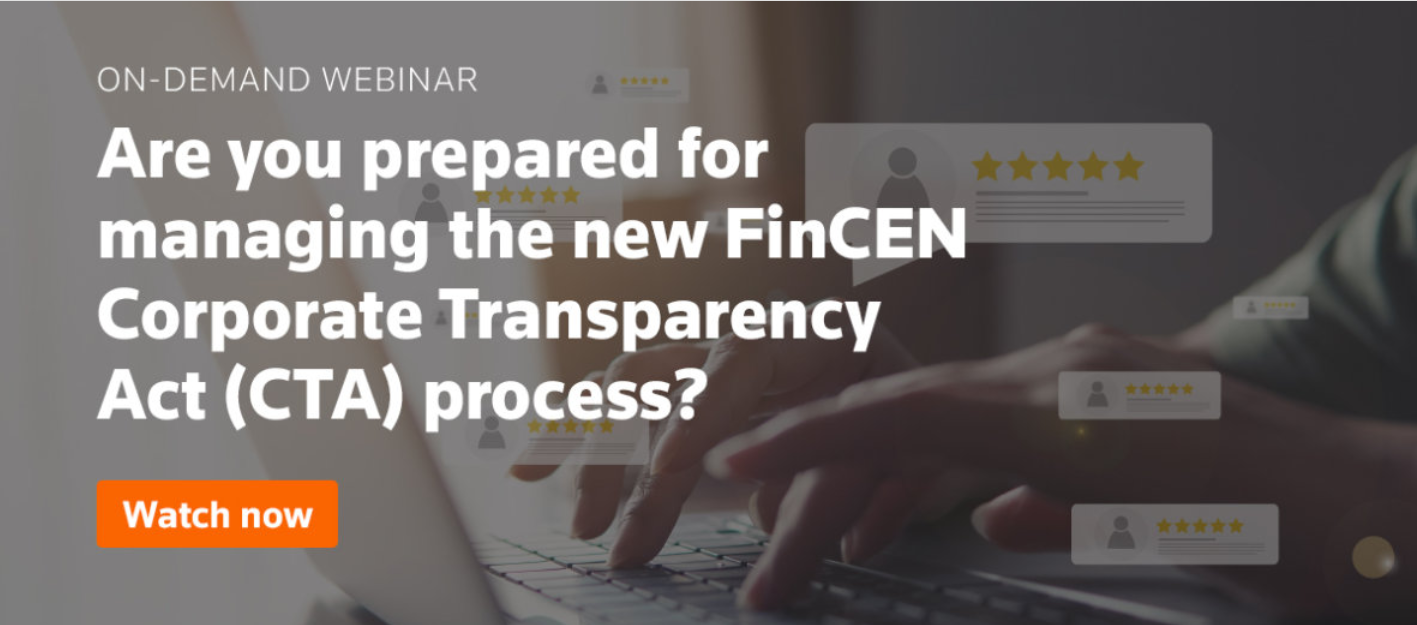The FinCEN Corporate Transparency Act (CTA) came into effect earlier in 2024 and it will put new reporting requirements on millions of businesspeople. And it’s a great opportunity for your firm – if you approach it the right way.
Jump to:
| What is CTA and who does it affect? |
| What are the opportunities for your law firm? |
| How HighQ can help |
| Making light work of heavy loads |
| Act now |
From outreach to intake, and everything in between leading up to submission with the federal government, this on-demand webcast shows you how simple it can be to manage this vast undertaking for your clients while creating a profit source for your firm.
Watch today: Are You Prepared For Managing the New FinCEN Corporate Transparency Act (CTA) Process?
What is CTA and who does it affect?
The CTA stems back a number of years to the Anti Money Laundering Act of 2020.
It’s designed to assist law enforcement and government agencies in tackling money laundering, tax fraud, financing of terrorism, and other illicit activities.
The act attempts to plug holes in the information that the government holds about individuals, and for the first time requires certain types of business entities to report beneficial ownership information and company information to the Department of Treasury.
The CTA has anonymous shell companies in its sights too, and establishes an obligation to report parties with substantial control – information that has in many cases not been disclosed to the government before.
Although there are multiple exemptions for companies that are already highly regulated, such as banks and insurance companies, the CTA will primarily impact small and midsize businesses, and many of them – especially small, single-owner LLPs linked to a small trust that nobody knows anything about. There are significant penalties for noncompliance, but these are not likely to be levied straightaway.
What are the opportunities for your law firm?
The Department of Treasury estimates that there could be 32M required filings in 2024 alone, and 15M each year going forward.
That presents a huge opportunity for your firm to support clients who need to file this information – especially as many firms’ clients routinely ask for businesses or trusts to be located in jurisdictions where they can be as anonymous as possible.
Under the CTA, two people have to be identified:
- Company applicants: the person who filed the document to create the register for the company
- Individual: primarily responsible for controlling or directing the filing
Reporting will be done through a secure online non-public system, Beneficial Ownership Secure System (BOSS). This has been designed to be user-friendly, but government processes are often far from that.
The CTA is a good opportunity to reach out to clients, especially ones you haven’t been in touch with for a while, to make them aware of their potential obligations, and offer support. In many cases, this will open up further conversations too – but in the short term, your firm should establish a service to help guide the CTA filing process.
How HighQ can help
Any kind of CTA support at scale needs a technology solution behind it. Handling thousands of clients, plus their confidential IDs, manually via email is completely unmanageable.
But this is where HighQ thrives. By creating forms, using automation, and managing workloads with custom dashboards, you can handle a huge number of clients without the manual effort.
This creates guardrails to guide clients through the process – from establishing whether filing is necessary, to collecting and submitting ID and the required information securely. And it’s a service that firms could charge out at a flat fee, which includes a paralegal having eyes on the submission before it goes to the government.
HighQ enables you to handle many thousands of applications all at once, tracking progress and moving clients through the process automatically.
HighQ is also scalable well beyond CTA.
Making light work of heavy loads
The biggest question for firms is, how do you streamline the work required to manage the CTA submission process?
To answer that, here is a suggested workflow that you can easily set up in HighQ:
- Connect with clients just to see if they are aware of CTA and the possible need to file.
- Link to a quick questionnaire to gauge whether they need to file. HighQ can provide confirmation based on their answers.
- As submissions come in, HighQ provides insight on volume and any flags – for example, if ID or information is missing, HighQ can ask the client to action this.
- The dashboard displays what’s pending, who’s assigned to each step or submission, and many other metrics and data points depending on what you want to analyze.
- Automatically email your client at each step – for example to confirm receipt of ID, when an attorney has reviewed the submission, and when it’s ready to file.
Act now
If you don’t have something in place soon, handling CTA filing for your clients will be a significant stress point by the end of 2024 – and beyond.







